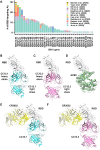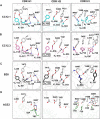This is a preprint.
Structural basis of a public antibody response to SARS-CoV-2
- PMID: 32577642
- PMCID: PMC7302194
- DOI: 10.1101/2020.06.08.141267
Structural basis of a public antibody response to SARS-CoV-2
Update in
-
Structural basis of a shared antibody response to SARS-CoV-2.Science. 2020 Aug 28;369(6507):1119-1123. doi: 10.1126/science.abd2321. Epub 2020 Jul 13. Science. 2020. PMID: 32661058 Free PMC article.
Abstract
Molecular-level understanding of human neutralizing antibody responses to SARS-CoV-2 could accelerate vaccine design and facilitate drug discovery. We analyzed 294 SARS-CoV-2 antibodies and found that IGHV3-53 is the most frequently used IGHV gene for targeting the receptor binding domain (RBD) of the spike (S) protein. We determined crystal structures of two IGHV3-53 neutralizing antibodies +/- Fab CR3022 ranging from 2.33 to 3.11 Å resolution. The germline-encoded residues of IGHV3-53 dominate binding to the ACE2 binding site epitope with no overlap with the CR3022 epitope. Moreover, IGHV3-53 is used in combination with a very short CDR H3 and different light chains. Overall, IGHV3-53 represents a versatile public VH in neutralizing SARS-CoV-2 antibodies, where their specific germline features and minimal affinity maturation provide important insights for vaccine design and assessing outcomes.
Figures





References
-
- Lurie N., Saville M., Hatchett R., Halton J., Developing COVID-19 vaccines at pandemic speed. N Engl J Med 382, 1969–1973 (2020). - PubMed
-
- Andrews S. F., McDermott A. B., Shaping a universally broad antibody response to influenza amidst a variable immunoglobulin landscape. Curr Opin Immunol 53, 96–101 (2018). - PubMed
Publication types
Grants and funding
LinkOut - more resources
Full Text Sources
Other Literature Sources
Miscellaneous
